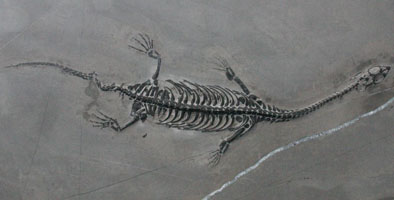Keichousaurus hui was a semi-aquatic reptile from Triassic China. They are believed to have lived in a marshy environment. Due to a robust ulna, it is believed that they were able to make their way onto land. They are considered members of the Pachypleurosauridae, which also included its contemporary the Nothosauridae. The genus name, Keichousaurus, is derived from the location where it was first found in 1957, Keichou Province.
Pachypleurosaurs are believed to have made their way to Europe, after having evolved in China, by way of the northern border of the Tethys Sea. They disappeared in the Triassic-Jurassic extinction.
Fossil evidence shows that Keichousaurus had a movable pelvis and may have given birth to live young instead of laying eggs. Their size ranged from 6-12 inches. They had pointed heads filled with sharp teeth which indicates they were aquatic and fish eaters. Based upon their abundantly large populations, it is believed that Keichousaurus was a prey species and was a valuable food source for larger predators.
The matrix which Keichousaurus is preserved in is a compacted fine volcanic ash and silt. The slate like matrix is frequently intersected by natural white calcite mineral formations that were deposited by water. The grey to black coloration of the bones is the result of inorganic minerals from the surrounding substrate replacing the organic minerals which made up the delicate bones.
Specimens are most commonly found in the ventral position, stomach uppermost, with the skull displayed from beneath. The most desired specimens are the dorsal presentations, which exhibit the skull cranial elements including its large orbits.
Kingdom: Animalia, Phylum: Chordata, Class: Sauropsida, Superorder: Sauropterygia, Order: Nothosauridae, Suborder: Pachypleurosaur, Genus: Keichousaurus, Species: hui.
This specimen is being offered from a private collection!
Keichousaurus hui 
Quantity in Basket: None
Code: OCF-703
Price: $2,000.00
Shipping Weight: 4.34 pounds
Time: Early Triassic, Spathian Stage, approximately 242 million years ago.
Location: Huxia Formation, Guangxi Province, China
Dimensions: 10-3/8" x 7-1/8" x 1/2"